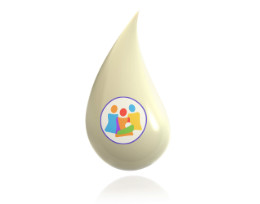Weaning the Breastfed or Human Milk-Fed Baby
Weaning is the process of either gradually or rapidly reducing the frequency of breastfeeding or pumping, leading to a decrease in milk production. Health outcomes for you and your baby are optimal if you can continue lactating for at least 2 years or longer (see our handout ‘Providing Human Milk: Does it Really Matter?’), but some lactating parents must wean earlier for many different reasons.
Here are some thoughts on weaning:
- If the baby is weaned before a year of age, the vitamin D supplement can be discontinued once the baby is no longer breastfeeding and is just taking formula. Formula has vitamin D in it.
- If you decide to decrease frequency of nursing/pumping, your production will very likely decrease over time. Your baby is still receiving many health benefits from your breastmilk even if you are supplementing with formula.
- Toddlers who are over 12 months of age are able to drink water and eat pretty much anything they won’t choke on. The frequency of toddler nursing varies greatly, with some nursing just before bed, while others still desiring to nurse every few hours. As the lactating parent, it is your decision what works best for you and your toddler. Many people who are breastfeeding their toddlers may pump once at work or not at all, depending on their milk production and comfort with going long periods of time without nursing or pumping.
- Ultimately, weaning partially or completely should be a personal decision by the lactating parent, and should not be a decision made by others, whether they be your healthcare providers, work colleagues, friends, or family members. Parents should not be threatened or shamed for feeding their infant or young toddler, or for weaning earlier than others expect them to. You should feel supported in reaching your infant feeding goals by those around you.
- If you have a high milk production, and you have difficulty dropping feedings or decreasing pump volumes over time, you should talk to a breastfeeding medicine specialist or lactation consultant to learn safe and effective weaning strategies.
Here are some tips on weaning:
Child-led weaning
This is a natural way of weaning older babies and toddlers. Your child gradually shows less interest in nursing over time, and eventually stops nursing. This is the easiest way to wean. Your milk production will gradually adjust and you will make less milk over time. If your child suddenly stops nursing and you do not want to maintain your milk production, then you will likely need to pump or manually express milk to comfort when you feel full, to more gradually wean and decrease the risk of mastitis, painful fullness, and other complications. When pumping to comfort, avoid fully emptying the breasts. Leaving some milk behind tells your body to make less milk.
Parent-led weaning by dropping nursing sessions
In this method, the lactating parent initiates weaning by dropping breastfeeding sessions gradually over time. If your child is still under 12 months, then replace the feed with a bottle or cup of stored expressed breastmilk, donor milk, or formula. After a few days, your breasts will decrease milk production to account for the dropped feed. If your breasts feel very full as you wait for the next breastfeed, pump or hand express to comfort. Once your breasts have adjusted to that dropped feeding, drop another breastfeeding session at the opposite time of day. Repeat this process until you are done breastfeeding. Once you drop your last nursing session, you may need to express milk to comfort 1-5 days after your last feed. It will often take 2 weeks for a mother who is fully nursing to wean. Some parents with high production or who are prone to mastitis or plugs may need to wean more slowly.
Weaning by pumping
If you have been primarily pumping or you need to stop breastfeeding immediately, you can wean via pumping. Rather than dropping pumping sessions like we suggest for breastfeeding, you would gradually increase the time between pump sessions. When weaning, only pump to comfort, not to complete emptiness. Pumping to complete emptiness sends a signal to your body to produce more milk, while leaving milk in the breasts decreases milk production. Let’s say you are pumping every 3 hours. See if you can pump every 4 hours, and reduce the amount of milk expressed either by shortening the time of milk expression, or by turning off the pump when the breasts feel comfortable. Some people turn off the pump when the milk flow slows to a trickle. Once you are comfortable pumping every 4 hours, then decrease pump frequency to every 6 hours, then eventually every 8-10 hours, etc. You should be comfortable without excessive fullness before increasing the intervals between pumpings. Most people are able to wean by pumping over a 2-3 week period.
Staying comfortable during weaning
- When your breasts feel full, you can either manually express or pump just to comfort. Leaving the breasts somewhat full tells your body that milk is no longer needed.
- Cold compresses can help with symptoms of fullness.
- A hot shower can help to release extra milk when feeling too full.
- Some herbs and medications can reduce milk production and may be appropriate to help with weaning, especially if rapid weaning is needed., Natural substances that can reduce milk production include peppermint, such as strong peppermint lozenges or peppermint tea. The herb sage also can reduce milk production. Sage can be purchased as an extract or added as an herb to your food. Decongestants such as pseudoephedrine and the birth control pill with estrogen as well as other medications may help with this process. Please speak with your doctor prior to starting any medications or herbs to ensure they are safe for you.
Weaning the toddler who loves to nurse
Toddlers and young children often breastfeed for comfort, security, relaxation, bonding time with mom, and nutrition. There is not an age at which breastfeeding is inappropriate. If you need to help your child wean, here are some strategies:
- If the toddler is still nursing whenever they want to, consider scheduling your toddler’s feeds so that the child is only nursing at times that are ideal for you – such as in the am upon awakening, before and after naps, and at bedtime. Sometimes this is liberating enough and some parents may choose to continue nursing with reduced frequency. It is totally fine to do this and stop at this step if that’s your preference.
- Once the toddler is on a nursing routine, start dropping nursing sessions. Depending on the age of the child, different strategies work to distract the child from nursing, such as reading books, playing together, going outside to play, or offering a special treat.
- Some toddlers adjust best if you are not around at that particular time of the dropped feeding. For example, if you want to stop nursing before the afternoon nap, ask someone else to put the toddler down for a nap while you take a walk. Changing the toddler’s routine may also help, such as having your partner or another caregiver put the child to bed at night.
- Children over age 2 often need guidance on their adjustment to weaning. This is similar to weaning from a pacifier or toilet training. You are respecting your child if you discuss the timeline for weaning, and ask them what will help them wean. For example, if the child likes to nurse before bed, ask them what might help them fall asleep without breastfeeding (e.g. a stuffed animal, music, a back massage, or a snack). Choose a future date that makes sense to your child (e.g. when their grandparents are planning to visit, or when they will start preschool). If children play a role in the planning, the transition is much easier!


